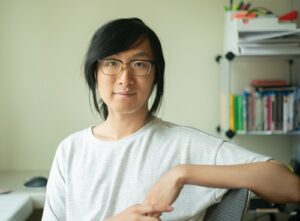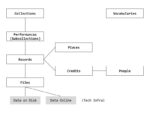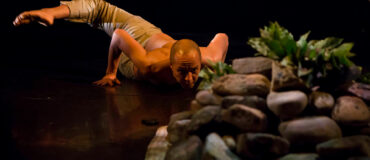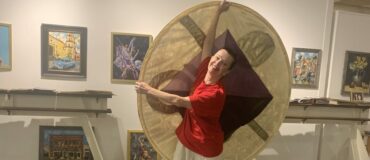By Lingyu Wang
Lingyu Wang is a 2022 Archiving and Preservation Fellow with Charya Burt Cambodian Dance. Read more about the Fellowships here. This is the first part of Lingyu’s blog.
August 1, 2022: A Convergent Force
A ceremony blessing a new theater. A conversation with an elder master. A stage performance at a festival. A reminder for washing your hands and wearing your masks. A convergent force in a diaspora community. If there is one thing that can be all of the above, it is Cambodian dance.

Charya Burt performing the Apsara Dance from the Cambodian Classical Dance Repertory. Photo by Bonnie Karmin Morrissey.
That statement has become very real for me as I work through the Charya Burt Cambodian Dance Digital Library. Charya’s current library of around 700 video clips is already a galaxy of things happening at once, and there are boxes of more physical materials to be documented and digitized. Charya has collaborated extensively with the Cambodian dance community, as well as Cambodian communities and dance communities at large. Her work covers mediums and techniques all across the span of traditional, modern, and contemporary, and she works through various aspects of shared pasts and recent histories. The classic repertories she performs are part of the effort to keep the dance tradition intact, and she has worked on many community-centered events and projects that we hope to document. Besides her own work, Charya also has many copies of videos from traditional dance schools which we hope to preserve, contextualize, and provide proper credit for, filling in blanks of Cambodian dance’s once almost lost history.

Charya Burt performing her original classical/contemporary work, Caressing Nostalgia. Photo by RJ Muna
That history is a lesson I am learning from Charya and her husband Rob Burt, their family friend and dance ethnologist Dr. Toni Shapiro-Phim, and archive technician Morgan Oscar Morel. Dance is an integrated and crucial part of Khmer culture. Even in the most difficult times, dance performances serve as social rituals that bring communities together, giving people the much-needed space to connect and heal. This dancing tradition was in great danger during the Khmer Rouge period, especially during the 1970s, when ideology-fueled genocide held intellectuals and artists as state enemies, and imprisoned and executed countless of them. Today, coming out of decades of bitter conflicts that extended all the way into the 1990s, people look again at dance as the way to recover culture and rebuild communities. Artists like Charya Burt keep dancing on.
Our main goal for the summer is to establish a taxonomy for Charya’s digital library, and this taxonomy will help Charya organize and document her nexus of work. Over the past weeks, we have gone through her current collection of video clips, seeking to organize them under dance titles, performances and occasions, instances of recordings, as well as dancers, schools, and community organizations. This will not only help Charya and Rob document future works, but also make the public-facing part of the digital library more useful for dancers, researchers, and community members. From there, we also hope to go through Charya’s physical archives, and establish an intake process for appraising, documenting, and digitizing these other materials. This process will need to be easy enough for Charya and Rob themselves to carry out at home within the limits of training, time, equipment and budget. I hope that what we do here will connect with even more dancers and dance communities out there documenting their works. Archiving, after all,can simply be another form of art to bring people together.
Check out screenshots of the Charya Burt Cambodian Dance Digital Library (click on thumbnails to expand).
- Entity-relationship diagram of the taxonomy, with both Airtable entities and data file entities stored in other technical infrastructures.
- Screenshot of Airtable taxonomy showing major entities, interrelations, and properties.
- Screenshot of nested collection view on Airtable, showing how individual records fit hierarchically into sub-collections, collections, and collection groups.
- Screenshot of single expanded record with detailed metadata and interrelated place and credit entities.
Top image: Charya Burt leading a community engagement workshop with the Wat Khmer Modesto Dance Group. Photo by Rob Burt. All photos courtesy of Charya Burt Cambodian Dance.
 Lingyu Wang (he/they) is a doctoral student in the School of Information and Library Science at University of North Carolina at Chapel Hill. His ongoing research looks at social movement archiving in Hong Kong, Mainland China, and beyond. He received a B.A. in Film and a B.S. in Computer Science from University of California, Berkeley, as well as a M.A. in Media, Culture, and Communication from New York University. Previously, he worked at the Media Resources Center at UC Berkeley, and served as graduate assistant at NYU Libraries’ Scholarly Communications Office. He has also extensively worked in film and stage productions.
Lingyu Wang (he/they) is a doctoral student in the School of Information and Library Science at University of North Carolina at Chapel Hill. His ongoing research looks at social movement archiving in Hong Kong, Mainland China, and beyond. He received a B.A. in Film and a B.S. in Computer Science from University of California, Berkeley, as well as a M.A. in Media, Culture, and Communication from New York University. Previously, he worked at the Media Resources Center at UC Berkeley, and served as graduate assistant at NYU Libraries’ Scholarly Communications Office. He has also extensively worked in film and stage productions.
Recent social movements across the globe have propelled Lingyu to study creative, performative forms of activism; people use these highly affective forms to resist erasure and build communities. Lingyu is thus drawn to Charya Burt, whose dances use a rich repertoire of mediums and techniques to discuss similar memories and histories. Together with Charya and her colleagues, he looks forward to pushing the archives’ boundaries to tell better stories and connect people with shared pasts.
____
We accept submissions on topics relevant to the field: advocacy, artistic issues, arts policy, community building, development, employment, engagement, touring, and other topics that deal with the business of dance. We cannot publish criticism, single-company season announcements, and single-company or single artist profiles. Additionally, we welcome feedback on articles. If you have a topic that you would like to see addressed or feedback, please contact communications@danceusa.org.
Disclaimer: Opinions expressed in guest posts do not necessarily represent the viewpoints of Dance/USA.









